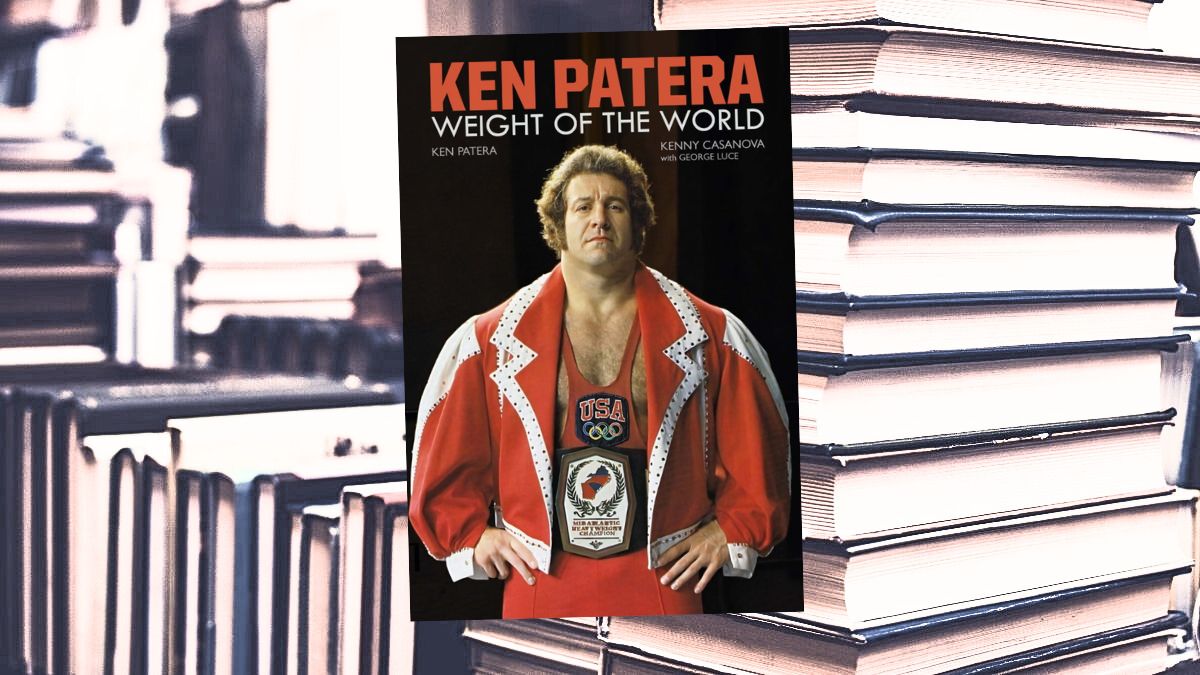Ken Patera: Weight Of The World
Ken Patera is a unique figure in the microcosm of professional wrestling. He seems to always be around the action or creating action in the major wrestling promotions of the 1970s and 1980s or his Olympic and Pan American Games achievements. What we, the fans, didn’t know is the man behind the weightlifting singlet.
That changed with the publication earlier this year of Ken Patera: Weight of the World. At 456 pages Patera and co-author Kenny Casanova tell a detailed story of growing up in the 1950s and progressing to the mature Patera of today.
The first thing that struck me about this book was the disclaimer by Patera himself. Patera apologizes upfront that what you are about to read is from a different time and much of it would not be socially acceptable in the world of today. He points out that you will read about drugs, sex, steroids, drinking and driving, cigarettes, dip, drinking from the garden hose and a lot of other stuff that the athlete of today would not do.
The life story is written in Patera’s voice. It is a consistent and realistic tone that created an inner image of the Olympic strong man talking directly to me. Casanova does a masterful job in framing the stories and voice of Patera in such a way that you can imagine Patera shaking his head and shrugging his big shoulders as if to say “Live and learn.” Ken Patera does not shy away from controversy and struggles as he remembers them. As far as wrestling books go, this one is as frank and honest as it can be when trying to remember details of matches, competitions and events that span 80 years. It is easy to forgive Patera for not remembering every detail. You are left feeling that he recalled the situations as best as he could and he sometimes adds a little flair.
Patera reveals that the power of the relatively new medium, television, opened horizons for him that he might not have been exposed to otherwise in his hometown of Portland, Oregon. The 1952 Olympics enthralled Patera with the thrill of competition and the variety of sports on the screen. In July 1953, Patera watched the first airing of promoter Don Owen’s show, Pacific Northwest Wrestling. He was amazed by the athleticism, mayhem and characters that seemed to call to him. Little did he know that wrestling would play a major role in his life.
The book is incredibly detailed, and at times it feels as if the reader is getting a year by year review. Patera and Casanova bring in a wide number of side characters to the narrative but they are all important to the shaping of Patera. One of the early years stories that stood out to me was the day Patera and a pal found an old weight set buried in their friend’s backyard. They lovingly cleaned the barbell and many plates. After a paint job, Patera found the inspiration to start lifting just like the guys he saw in the Olympics.
Throughout his teenage and even university years Patera seems to wander, seeking out the path he needs to take to be a success. Would he be a scholar? What sport should he play? What was he passionate about? The journey to weightlifting success is filled with stops and starts but this is where he finds success.
Legendary wrestler and owner of the famed AWA, Verne Gagne plays a major role in the development and feeding of Patera in his Olympic quest. Upon hearing about the powerlifter who was outlifting every NFL player on the Minnesota Vikings, Gagne needed to meet Patera. At the AWA offices Gagne offered to sponsor the strongman for $100 a week to help him get to the Olympics with the caveat that Patera join his promotion once he is done.
Patera qualified for the Munich Olympics and really enjoyed the spirit of competition with athletes from across the globe. While at the Games he witnessed tragedy and heartache as terrorists murdered Israeli athletes.
The rest of the book is very interesting as Patera learns the ropes of wrestling and starts working with top guys right away in order to maximize his fame as a weightlifting record holder and Olympian. He does the rounds of the territories of North America meeting the future legends of the sport such as Ric Flair, Bob Backlund, Dusty Rhodes and Andre the Giant.
While the struggles of professional wrestlers captivates me, the intimate and funny stories are the ones that captivate me. I don’t want to give too much away but a certain promoter essentially provides Patera with his mistress as a way of sealing the deal. Patera instead shows some class and he and the mistress just end up eating ice cream and watching a movie on TV.
The famous McDonald’s boulder story has been retold many times by wrestlers over the years in their own books. The point Patera makes in his tome is that there were very few witnesses to the evening’s events and everyone else is just telling a tale. Patera gives his side of the story and I believe he felt some serious shame from the incident. He did go to jail, but he was able to finish his university degree.
A story that was largely unknown was that Vince McMahon sent money to Patera’s family every week while he was in prison so that they never suffered. Sure Vince worked Patera hard when he got out and got every dime back, but that was a solid move overall.
I enjoyed Patera’s book as the length of it was not a burden to the reader because of the personally engaging way the book was written. There are so many fun stories revealing the inner workings of wrestling and Patera’s journey through life. I highly recommend this Ken Patera: Weight of the World.




